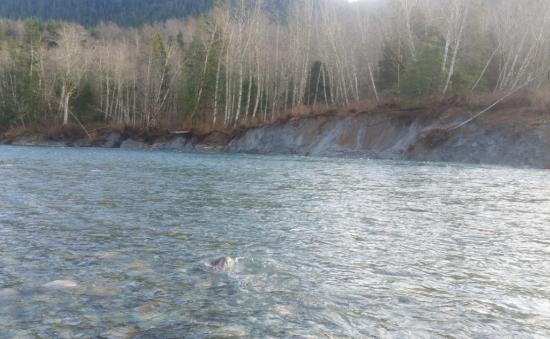‘Worst Ever Return’ Of Puget Sound Steelhead
Welcome to the weird world that is Pugetropolis steelheading circa 2020.
Even as angling reopens on sections of most of them today, state managers are dealing with a significant eggtake shortfall on three of four east Puget Sound river systems due to “the worst ever return” of the popular fish.
According to WDFW’s Edward Eleazer, Kendall Creek on the North Fork Nooksack saw a shortfall of 182,000 fertilized eggs, Whitehorse on the North Fork Stillaguamish 146,000 and Wallace/Reiter on the Skykomish 103,000 — all totaled 431,000 eggs.

Now for a brief mea culpa: The initial headline on the emergency rule change notice I posted yesterday afternoon announcing the reopening of retention of adipose-clipped steelhead on select stretches of three Snohomish and King County river systems mistakenly suggested that broodstock needs had been met because I misread WDFW’s reasoning.
My apologies, as in fact spawning goals were met on only one.
You would think that the rivers should stay shut to try and meet eggtake goals, or to stretch out the run by collecting late-arriving fish to spawn, but under the NOAA-Fisheries permit to operate the Chambers Creek early winter steelhead programs, WDFW can’t use adults that return after Jan. 31 for broodstock purposes, meaning that the fish still in the rivers afterwards are superfluous to spawning needs and thus available for harvest/removal.
The collection cutoff is done to segregate returns of wild and hatchery stocks as much as possible, according to Eleazer.
“We don’t want hatchery broodstock to creep later and later. We have a hard deadline of Jan. 31 as a safety precaution,” he said.
Where other sections of Puget Sound rivers close after the end of January for steelhead, terminal zones on the above rivers and the few others with Chambers fish are typically open through Feb. 15 to allow anglers to try and catch as many clipped ones as possible to prevent them from possibly interbreeding with natives.
As for the 11-day fishing window that began today to try to remove any last returning hatcheries, given the atmospheric hose pointed straight at Pugetropolis, it likely won’t be until very late this weekend if not early next week that anglers will be able to chase the few fish that are still around, though they won’t have seen many lures all season.
Indeed, too much water will bookend a season that began with too little water, as well as very low initial returns that saw WDFW shut down retention in December to try and get as many steelhead back to the hatcheries as possible.
“This is the worst ever return to Puget Sound,” Eleazer said. “It plays into the same thing as the Skagit — poor freshwater and saltwater rearing conditions.”
The Skagit and Sauk’s catch-and-release season for wild winters in February, March and April was cancelled last month after the forecast came in below 4,000, too few steelhead to cast for due to impacts on the stock from other fisheries.
Pointing to The Blob, WDFW said those low returns were “likely the result of severe drought and low river flows in 2015 and 2016, as well as an unprecedented marine heatwave in the Pacific Ocean that negatively affected survival rates.”
Eleazer did note that while Puget Sound programs were seeing anemic runs, those on the Olympic Peninsula had met their broodstock goals and a bit more.
“There’s a Puget Sound element that’s applying extra pressure that we don’t understand,” he stated.
Predation by harbor seals has been eyed as a serious problem for young steelhead migrating out of Deep South Sound and Hood Canal.
If there’s a glimmer of good news, it’s that at least Tokul on the Snoqualmie met its broodstock goal.
Yet still, according to WDFW’s latest hatchery escapement report, as of Jan. 27, a paltry 237 adults had returned to Tokul, Kendall, Whitehorse, Wallace and Reiter, with just 255,027 eggs taken, a far cry from the relatively high abundance of the winter of 2017-18, which saw an overall return of 1,229 adults that produced 801,407 eggs.
With Puget Sound wild steelhead listed under the Endangered Species Act and as a result of the federally approved hatchery genetic management plan for the Chambers program, WDFW can only release up to 521,600 winter smolts annually into the Nooksack, Stilly, Sky/Wallace and Snoqualmie.
Meaning the agency and the fishery are now in a very tight spot coming out of this winter.
“We’re working with our comanagers and NOAA to figure out solutions moving forward,” Eleazer said.
ALSO OF NOTE
Yesterday’s WDFW e-reg opening the North Fork Stillaguamish from French Creek up to the Swede Heaven Bridge conflicted with the fishing pamphlet. The printed regs state that those waters closed as of Jan. 31 for steelhead, though game fish remain open through Feb. 15.
Eleazer believes that is an error and was looking into sending out an updated notice that would reopen that water through the 15th for retention of fin-clipped steelhead.
Watch this space for that change.
(Editor’s note Feb. 6, 2020, 3:30 p.m.: WDFW has tweaked its e-reg to clarify the daily limit, two hatchery steelhead, and dates of the above fishery, Feb. 5-15. Also, the online PDF of the fishing pamphlet has been updated on page 1 with corrected regulations for the North Fork Stillaguamish between French Creek and Swede Heaven Bridge, i.e., hatchery steelhead retention is open in that stretch through Feb. 15, not Jan. 31 as originally printed.

